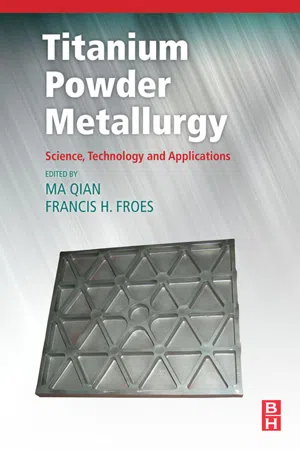
- 648 pages
- English
- ePUB (mobile friendly)
- Available on iOS & Android
About This Book
Titanium Powder Metallurgy contains the most comprehensive and authoritative information for, and understanding of, all key issues of titanium powder metallurgy (Ti PM). It summarizes the past, reviews the present and discusses the future of the science and technology of Ti PM while providing the world titanium community with a unique and comprehensive book covering all important aspects of titanium powder metallurgy, including powder production, powder processing, green shape formation, consolidation, property evaluation, current industrial applications and future developments. It documents the fundamental understanding and technological developments achieved since 1937 and demonstrates why powder metallurgy now offers a cost-effective approach to the near net or net shape fabrication of titanium, titanium alloys and titanium metal matrix composites for a wide variety of industrial applications.
- Provides a comprehensive and in-depth treatment of the science, technology and industrial practice of titanium powder metallurgy
- Each chapter is delivered by the most knowledgeable expert on the topic, half from industry and half from academia, including several pioneers in the field, representing our current knowledge base of Ti PM.
- Includes a critical review of the current key fundamental and technical issues of Ti PM.
- Fills a critical knowledge gap in powder metal science and engineering and in the manufacture of titanium metal and alloys
Frequently asked questions
Information
A historical perspective of titanium powder metallurgy
Abstract
Keywords
1.1. Introduction
1.2. The early years (late 1940s to early 1950s)
Table of contents
- Cover
- Title page
- Table of Contents
- Copyright
- List of contributors
- About the editors
- Preface
- 1: A historical perspective of titanium powder metallurgy
- 2: Conventional titanium powder production
- 3: Production of titanium powder by an electrolytic method and compaction of the powder
- 4: Titanium powder production via the Metalysis process
- 5: Direct titanium powder production by metallothermic processes
- 6: Research-based titanium powder metallurgy processes
- 7: Titanium powders from the hydride–dehydride process
- 8: Low-cost titanium hydride powder metallurgy
- 9: Production of titanium by the Armstrong Process®
- 10: Hydrogen sintering of titanium and its alloys
- 11: Warm compaction of titanium and titanium alloy powders
- 12: Pressureless sintering of titanium and titanium alloys: sintering densification and solute homogenization
- 13: Spark plasma sintering and hot pressing of titanium and titanium alloys
- 14: Microwave sintering of titanium and titanium alloys
- 15: Scavenging of oxygen and chlorine from powder metallurgy (PM) titanium and titanium alloys
- 16: Titanium metal matrix composites by powder metallurgy (PM) routes
- 17: Titanium alloy components manufacture from blended elemental powder and the qualification process
- 18: Fabrication of near-net-shape cost-effective titanium components by use of prealloyed powders and hot isostatic pressing
- 19: Metal injection molding of titanium
- 20: Powder-processing linkages to properties for complex titanium shapes by injection molding
- 21: Titanium sheet fabrication from powder
- 22: Cold-spray processing of titanium and titanium alloys
- 23: Thermal spray forming of titanium and its alloys
- 24: The additive manufacturing (AM) of titanium alloys
- 25: Powder-based titanium alloys: properties and selection
- 26: A realistic approach for qualification of PM applications in the aerospace industry
- 27: Powder metallurgy titanium aluminide alloys
- 28: Porous titanium structures and applications
- 29: Microstructural characterization of as-sintered titanium and titanium alloys
- 30: Future prospects for titanium powder metallurgy markets
- 31: A perspective on the future of titanium powder metallurgy
- Index